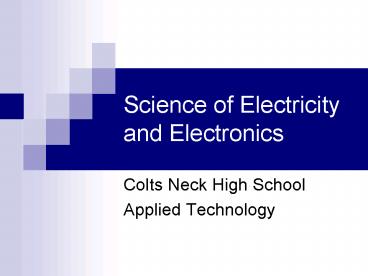Science of Electricity and Electronics - PowerPoint PPT Presentation
1 / 14
Title:
Science of Electricity and Electronics
Description:
Science of Electricity and Electronics. Colts Neck High School. Applied Technology ... Electron Flow Theory (EFT) A theory which states that electrons flow from ... – PowerPoint PPT presentation
Number of Views:22
Avg rating:3.0/5.0
Title: Science of Electricity and Electronics
1
Science of Electricity and Electronics
- Colts Neck High School
- Applied Technology
2
The Nature of Matter
ELEMENT
COMPOUND
Mixture of two or more elements.
Pure form of matter.
ATOMS
MOLECULE
Smallest part of an element.
Smallest part of a compound.
Electrons Negative part of atom
Protons Positive part of atom
Neutron No charge or neutral part
3
The Atom
4
Ionization
- Ionization occurs when an atom loses or gains an
electron. It is caused by heat, friction, or
bombardment by electrons. - Positive Ion an electron leaves the atom,
leaving the atom positively charged. - Negative Ion an electron is gained by the atom,
leaving the atom negatively charged.
5
Static Electricity
- Law of Charges
- Like charges repel each other, and unlike charges
attract each other. - Electrostatic Field
- The field of force surrounding a charged body.
6
Transfer of Electrons
- Conduction
- Transferring electrons by directly touching two
object together or by connecting them with a
conductor. - Induction
- Changing the charge of an object by bringing it
near a charged object. When an object is charged
by induction it takes on the opposite charge.
7
Application of Static Electricity
8
Basic Electric Circuits
- Voltage the force behind electron flow.
- (V) the symbol that represents voltage
- Similar to horsepower in an engine
- Current the flow of electron.
- (A) the symbol that represents ampere
- Similar to the speed of a flowing river
- Resistance the opposition to the flow of
electrons - (?) the symbol that represents ohms
9
Conductors and Insulators
- Conductors allow for the free flow of
electrons. - copper, aluminum, salt water, damp earth
- Insulators prevent the free flow of electrons.
- glass, porcelain, air, sand, paper, oil
- Semi-conductors considered neither a good nor a
poor conductor.
10
Circuits
- Series Circuit electrons have only one path to
follow. - Parallel Circuit electrons have multiple paths
to follow.
11
Electron Flow
- Conventional Current Flow (CCF) - Electricity
flowed from positive to negative. A theory that
was created over 200 years ago, when scientists
arbitrarily chose a polarity direction. - Electron Flow Theory (EFT) A theory which
states that electrons flow from negative to
positive, and which is widely accepted as
correct. - Many schematic drawings are still drawn in CCF
12
Electric Current
- Direct Current
- Current flows in only one direction in an
electrical circuit. - Example - Battery
- Alternate Current
- Current flows in both directions in an electrical
circuit. - Example Home Outlet
13
Ohms Law
- Current measured in amperes (I) in a circuit is
equal to the applied voltage (E) divided by the
resistance (R).
E I x R I E / R R E/I
Applied voltage is equal to the current
multiplied by the resistance. Current is equal to
applied voltage divided by the resistance. Resista
nce is equal to the applied voltage divided by
the current.
14
Electrical Prefixes
- tera T 10x12
- giga G 10x9
- mega M 10x6
- kilo k 10x3
- basic unit
- milli m 10x-3
- micro µ 10x-6
- nano n 10x-9
- pico p 10x-12































